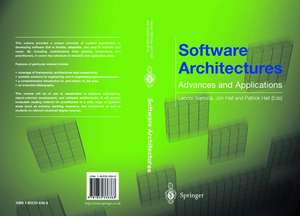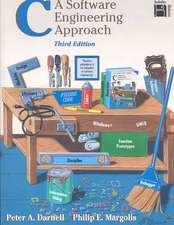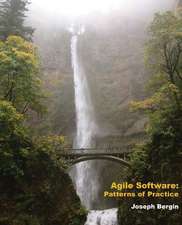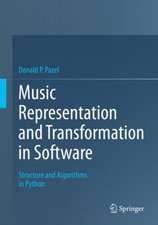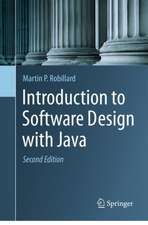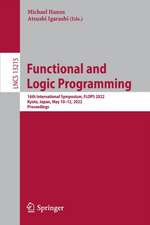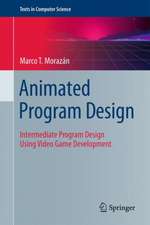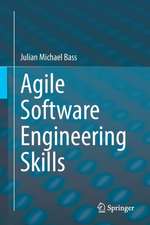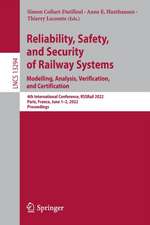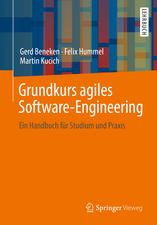Software Architectures: Advances and Applications
Editat de Leonor Barroca, Jon Hall, Patrick Hallen Limba Engleză Paperback – 15 oct 1999
Preț: 646.30 lei
Preț vechi: 807.87 lei
-20% Nou
Puncte Express: 969
Preț estimativ în valută:
123.69€ • 128.65$ • 102.11£
123.69€ • 128.65$ • 102.11£
Carte tipărită la comandă
Livrare economică 14-28 aprilie
Preluare comenzi: 021 569.72.76
Specificații
ISBN-13: 9781852336363
ISBN-10: 1852336366
Pagini: 296
Ilustrații: XIX, 272 p. 36 illus.
Dimensiuni: 155 x 235 x 16 mm
Greutate: 0.44 kg
Ediția:2000
Editura: SPRINGER LONDON
Colecția Springer
Locul publicării:London, United Kingdom
ISBN-10: 1852336366
Pagini: 296
Ilustrații: XIX, 272 p. 36 illus.
Dimensiuni: 155 x 235 x 16 mm
Greutate: 0.44 kg
Ediția:2000
Editura: SPRINGER LONDON
Colecția Springer
Locul publicării:London, United Kingdom
Public țintă
ResearchCuprins
1. An Introduction and History of Software Architectures, Components, and Reuse.- 1.1 Introduction.- 1.2 Software Architecture.- 1.3 Reusable Components.- 1.4 Setting a Context for Component Reuse.- 1.5 Components and How to Use Them.- 1.6 Current and Future Developments.- 2. Components, Scripts and Glue.- 2.1 Introduction.- 2.2 Motivation and State-of-the-Art.- 2.3 A Conceptual Framework for Software Composition.- 2.4 PICCOLA ? a Small Composition Language.- 2.5 Discussion.- 2.6 Conclusions.- 3. Business Component Development.- 3.1 Introduction.- 3.2 Business Component Concepts.- 3.3 Business Component Run-time Concerns.- 3.4 Business Component Development Process Concerns.- 3.5 Summary.- 4. Designing Component Kits and Architectures with Catalysis.- 4.1 Introduction.- 4.2 What is a Component?.- 4.3 Families of Products from Kits of Components.- 4.4 Catalysis: Modelling Component Behaviour.- 4.5 Modelling for Component-Based Development.- 4.6 Summary.- 5. Reuse Requires Architecture.- 5.1 Introduction.- 5.2 What do we Mean by Software Architecture?.- 5.3 Case Study in Reuse ? Matra Cap C3 Systems.- 5.4 Architecture-Based Reuse.- 5.5 Organisation and Technology.- 5.6 Managing the Technology.- 5.7 Components and Reuse.- 5.8 Summary.- 6. Designing Software Architectures Through Evaluation and Transformation.- 6.1 Introduction.- 6.2 Requirements Terminology.- 6.3 Example.- 6.4 Overview of the Method.- 6.5 Functionality-Based Architectural Design.- 6.6Assessing Quality Attributes.- 6.7 Architecture Transformation.- 6.8 Related Work.- 6.9 Conclusions.- 7. An Architecture for Internet Business Applications with Business Components.- 7.1 Introduction.- 7.2 Example.- 7.3 Database Access.- 7.4 A One-Layer Two-Tier Internet Business Application Architecture.- 7.5 Vision forInternet Business Applications.- 7.6 Internet Object Server for Business Entities with RMI.- 7.7 Business Entities Versus Business Processes.- 7.8 Five-Layer Architecture.- 7.9 Providing Layers of Business Objects as Components.- 7.10 Business Components.- 7.11 Conclusions.- 7.12 Acknowledgments.- 8. Lean Product-Line Architectures for Client-Server Systems – Concepts & Experience.- 8.1 Introduction.- 8.2 The CACS System: an End User Perspective.- 8.3 Rearchitecting Client-Server Systems.- 8.4 Framework Technology and Reflection as a Basis of Self-Configuring Product-Line Architectures.- 8.5 A Sample Framelet Family.- 8.6 Discussion and Conclusions.- 9. Issues in Industrial Product-Line Architectures.- 9.1 Introduction.- 9.2 The Case Study.- 9.3 Product-Line Architectures and Reusable Assets.- 9.4 Issues in Product-Line Architectures.- 9.5 Related Work.- 9.6 Conclusion.- 10. Architectural Standards, Processes and Patterns for Enterprise Systems.- 10.1 Today’s Enterprises Face Increasing Competitive Challenges.- 10.2 Distributed Components Offer a Route Forward.- 10.3 “Reuse” Really Means Achieving Economies of Scale.- 10.4 A Component-Capable Organisation Must be Mature.- 10.5 There are Several Synergistic Standards for Enterprise Components...- 10.6 Enterprise Components Require a New Generation of Middleware.- 10.7 Architecture Patterns are Encapsulated Solutions to the Distributed Application Design Problem.- 10.8 Conclusion.- 11. How Not to Reinvent Some Wheels: Lessons from Interactive System Architectures.- 11.1 Lessons from Another Place.- 11.2 Boxes and Arrows are Not Enough.- 11.3 Properties, Not Topologies.- 11.4 Domain Decompositions are Essential.- 11.5 Interactions Between Quality Attributes and Software Architectures.- 11.6 Trade-Offs areUnavoidable.- 11.7 Tools are Essential, but Virtually No Good Ones Exist.- 11.8 Conclusions.- 11.9 Acknowledgements.- 12. An Industrial Perspective.- 12.1 The Current Situation.- 12.2 Architectural Approaches to Software Engineering in Industry.- 12.3 Software Architectures and Component Engineering in Philips.
Caracteristici
Provides a collection of state-of-the-art readings in software architectures
